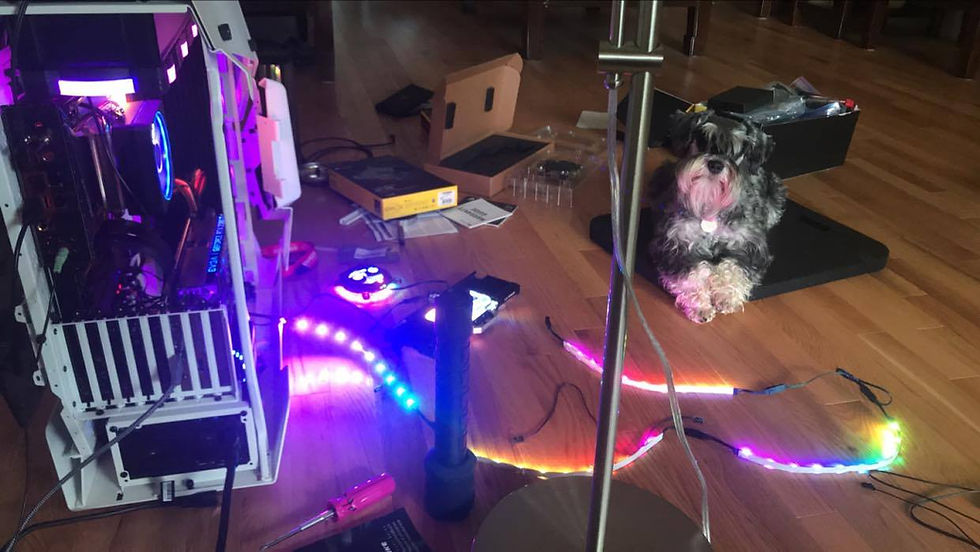
In mid-April, 2020, my faithful decade-old computer started announcing woeful death cries. After years of heavy graphical animation rendering abuse, she decided that enough was enough and blacked out with a BIOS failure. After much panicking, and a stressful day of researching, I was able to overwrite the dead BIOS. However, I would no longer subject my custom mobile-desktop to any more challenging work other than internet surfing and light Photoshop projects. She may succumb to inevitable fate of turning into a brick any day. She served her purpose, and for many years was an incredibly powerful 18-inch gaming laptop, but alas, her days have passed. Thus, my quest had begun. I needed to find my new loyal steed. (I will continue to anthropomorphize my computers throughout the article.)
I needed to find a new companion that would be able to support my growing animation needs and be the ideal AI powerhouse for the next decade or more of research and pursuing my PhD. Since I was in a pinch and pressed for time, I started looking at ready-made, customizable AI or gaming computers. However, being in the midst of a global pandemic, I quickly realized that it was the best and worst time to buy/build. On one hand, I had abundant time to research and build one at home. On the other hand, due to factory closures, people globally working from home, delays in product releases, and scarcity of products, the prices for components were skyrocketing.
While buying a pre-made desktop was the faster and easier solution, the prices for all the specifications that I needed would have resulted in spending over $10,000. So I set my goal to make my ultimate custom desktop computer for less than a factory-build. I’m pleased to say that I reached that goal, and here are a selection of major components that I purchased. (The end product of this article is a completed air-cooled build as I am still waiting for all of the liquid-cooling components to arrive.)

My shopping list included the following major components:
Of course, other shopping items included various cables and a new keyboard. Let me tell you, that finding an AZERTY French gaming keyboard was a time consuming task. It involved one month of research and over one month to get one shipped from China since SteelSeries and Glorious were indefinitely sold out. Only 105-key international keyboards were options I considered since that’s all I’m comfortable using.
To figure out which parts I would buy for the build, I read articles, reviews, product comparisons, performance tests, and watched many videos. When it came time for the actual build, the user manuals and brand websites were my main resource. However, the user manuals and product information that came with the components, for the most part, had terribly drawn diagrams that were often too small or inaccurate. This resulted in a lot of time doing additional research and relying on trial and error.
My very first purchase was the case. I knew I needed a giant tower case in order to fit all my components and the extended ATX motherboard. But, I didn’t have a vision for what I wanted the case to look like, I just knew I wanted a sturdy, open air-flow case with lots of flexibility for full dismantling. As the build progressed, my vision of the project also evolved. Placement for many of the components changed as more of them were installed in the case-frame to help with cable management and airflow efficiency. For example, the GPU was originally horizontally mounted, but I spent an entire day and an extra $100 on a cable to convert it to a vertical mount to reduce strain when the system gets converted to liquid-cooling. (It looks way cooler with the light effects this way too.)
Shockingly, all the parts I ordered from Europe arrived within a week while many parts I ordered from the other side of Canada took two months. I am still patiently waiting for the fittings that will allow me to start the liquid-cooling conversion of the entire system.
As a testament to the skyrocketing prices in computer parts, they are still steadily rising. While I managed to procure my GPU for $2,000, my exact GPU is currently indefinitely on back order and the comparable GPU is now priced at just over $3,000. Luckily, I also took advantage of some sales to buy my Attack Helicopter case at half price. I managed to save on some parts and got gouged on others. But now, I do have a really cool disco-rave tower that is reminiscent of a psychedelic Stormtrooper and big enough to be a dog-condo for my miniature schnauzer. As an added bonus, my computer is currently weighing in at a whopping 35 kg, but she will probably still bloat by another 10 kg with the filled water-glycol cooling system. I can confidently say that I am no longer working with a portable tool since she weighs more than me and needs a trolley for transport.

Being my first computer build, a lot of unexpected surprises happened. Initially I thought it would all be assembled over a weekend once all the major parts arrived. But all the major parts did not arrive in a timely fashion and the build stretched out over two months. A lot of trouble shooting was involved. Plenty of frustration and anger ensued from fiddling in hard to reach locations and trying to figure out why certain things weren’t working. The most frustrating part of all was just getting the LED lighting to work. After about six hours of cursing and diagnostics, I figured out I had a faulty wire harness. Once that was replaced, it worked instantaneously. But since every component except the cables and radiators have LEDs, I had to wrestle with coordinating three separate control softwares with one of them only being compatible with Windows. The latter being an unfortunate annoyance for me since I primarily work in Linux and have the computer set up as a dual boot system with Linux priority. So 90% of the time I am working on my computer, my PSU LEDs are off.
On the software side of things, I loaded Windows as the first OS and Linux as the second since Linux is the more accommodating OS and this avoided potential screw-ups. For fun, I started modifying and coding a custom Conky interface for my Linux desktop which results in a moving dashboard monitoring system for my computer components, temperatures, usage, and life organization. While it is a long way from being complete, I’m having a fun time learning Lua as a coding language and making an interface that would make Tony Stark and Jarvis proud.
I’ve been using my new computer for a few weeks now and she is a smooooooth, fast, silent beast. It will be exciting to not only test her AI and Graphic capabilities in the workplace, but to try her out with some hardcore gaming too.














































Comments